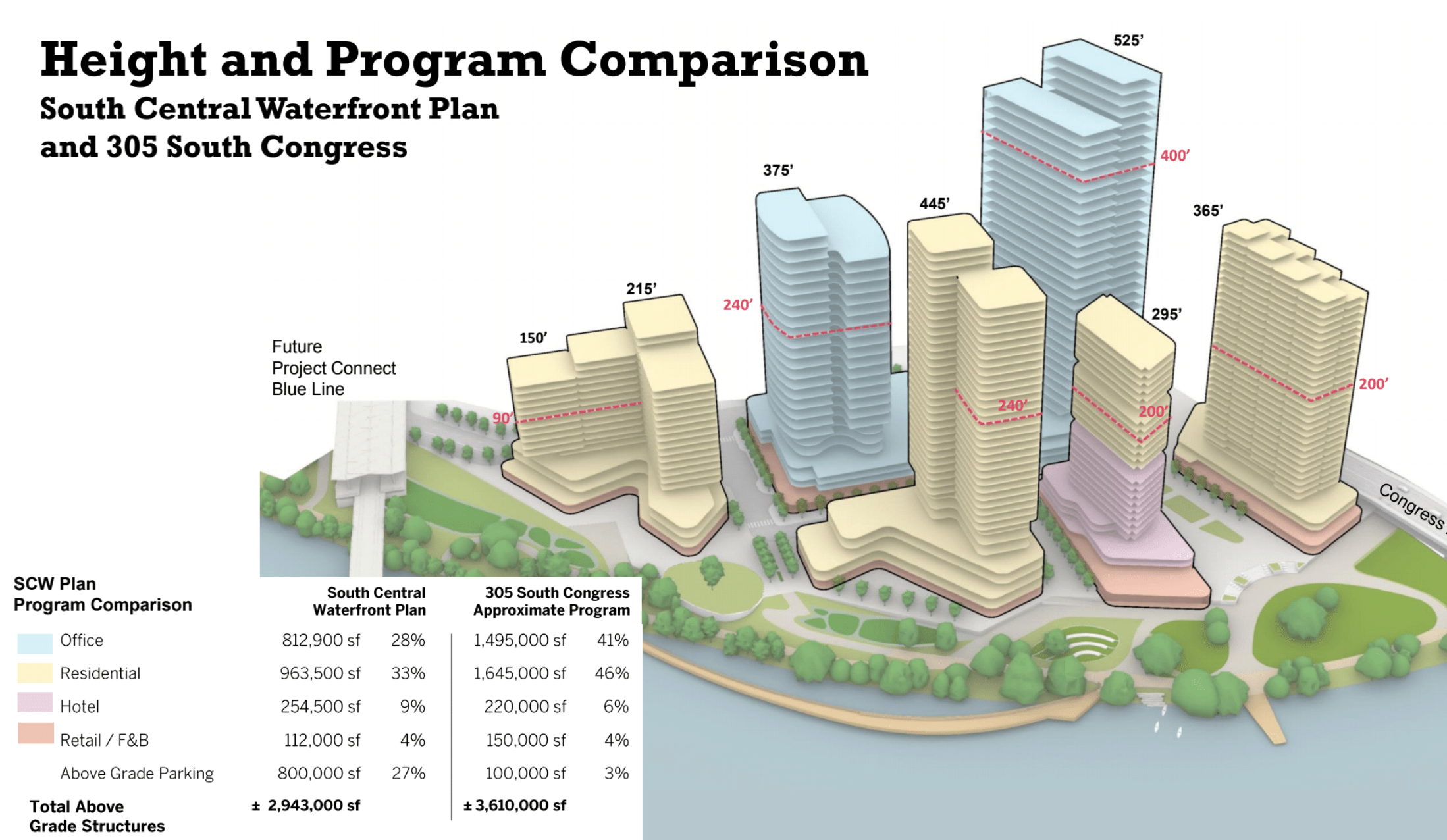Statesman PUD gets first Planning Commission hearing
Monday, December 20, 2021 by
Jonathan Lee As the long-anticipated redevelopment of the Austin American-Statesman site at 305 S. Congress Ave. heads toward a City Council vote next year, the development team presented its vision to the Planning Commission on Dec. 14.
Preliminary plans for the nearly 19-acre planned unit development, known informally as the Statesman PUD, include 3.6 million total square feet of residential, office and hotel uses spread across six towers ranging from 215 to 525 feet tall. This includes 1,378 residential units, 1.5 million square feet of offices, a 275-room hotel, and 150,000 square feet of retail and restaurants.
Over 8 acres of parks, plazas and trails are planned along the shores of Lady Bird Lake, including a Great Lawn, a boardwalk and pier, a reconstructed hike and bike trail, enhanced bat-watching areas, as well as native landscaping and rain gardens. All public space will be ADA accessible.
Plans also call for a Project Connect Blue Line station, new streets (including an extension of Barton Springs Road), as well as protected bike lanes and trail connections.
The project’s team includes Endeavor Real Estate Group, architecture firm Skidmore, Owings & Merrill (SOM), and Armbrust &Brown attorney Richard Suttle.
Suttle said the plan will provide everything lacking from the current site, which is basically an office building with a huge parking lot. “There’s no parkland out there; there’s no roads,” Suttle said. “And what this plan proposes is parks, roads, transit, open space, housing and trails.”

A massing shows the proposed building heights and densities compared to the vision under the South Central Waterfront Plan. Image by Skidmore, Owings & Merrill (SOM), courtesy Elaine Garza.
Due to the complexity of the project, the commission postponed its recommendation to late January to allow for more discussion.
“This is a once in a generation, once in a lifetime opportunity to develop this piece of property,” Commissioner Grayson Cox said. “We need to get it right.”
Planning commissioners spoke constructively about the plan, airing concerns and seeing if there was room to squeeze more benefits from the developer.
“If big profits are anticipated, we want to see big community benefits as well,” Commissioner Solveij Rosa Praxis said. Suttle countered that “you have to take into account the massive cost” to build the project plus the dedication of park and road space.
The affordable housing contribution was one area some deemed lacking, with only 4 percent of units set to be income-restricted. Though the South Central Waterfront Plan, passed in 2016, calls for 20 percent of units in the district to be affordable, it recommends that the Statesman site only have around 4 percent affordable housing since the land is so expensive and much of it will be dedicated to parks and roads.
Most of the public benefit comes from parks. The developer will pay for most of the pedestrian and park improvements, including the Great Lawn, trail restoration, landscaping, trail connections and plazas. That leaves the city to pay for the planned boardwalk and pier as well as the extension of Barton Springs Road, among other infrastructure. Much of this money will likely come from the tax increment reinvestment zone that Council plans to establish by the end of the year.
Commissioner Claire Hempel worried park maintenance costs could burden the Parks and Recreation Department. PARD staff said that though the department is automatically responsible for maintenance of public parks, the city and developer will likely use various funding mechanisms to keep up the park in addition to money from PARD’s limited budget.
Commissioner Jeffrey Thompson questioned why the extension of Barton Springs Road through the site would be four lanes – two more than what the South Central Waterfront Plan laid out. He also worried a planned two-way cycle track alongside the road would not feel safe for most users.
ATD said that because the development could produce 18,000 car trips per day even with demand management, the road capacity is needed. The development team, fearing congested roads, has also insisted on four lanes. Ninety-five percent of the parking in the development will be located underground, which Jerry Rusthoven with the Housing and Planning Department considers “a very huge get for the city” to avoid “a wall of parking garage” along the lakefront.
The PUD has also gone to several other boards and commissions so far. Two of them – the Parks and Recreation Board and the Environmental Commission – did not recommend the PUD and requested changes to the proposal. The development team has since taken care of all the parks board’s requests and almost all of the Environmental Commission’s concerns. The boardwalk’s impact on the shoreline remains the main point of contention – it will likely need a City Council variance to get around watershed protection rules.
Before the Planning Commission discusses the case again on Jan. 25, a working group will meet to form recommendations. “We’ve done that before, and it really pays off,” Chair Todd Shaw said. After that vote, City Council will get the final say on the PUD.
The Austin Monitor’s work is made possible by donations from the community. Though our reporting covers donors from time to time, we are careful to keep business and editorial efforts separate while maintaining transparency. A complete list of donors is available here, and our code of ethics is explained here.
You're a community leader
And we’re honored you look to us for serious, in-depth news. You know a strong community needs local and dedicated watchdog reporting. We’re here for you and that won’t change. Now will you take the powerful next step and support our nonprofit news organization?




